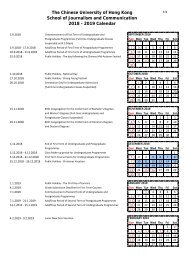Create successful ePaper yourself
Turn your PDF publications into a flip-book with our unique Google optimized e-Paper software.
Source: Tommy Wong<br />
data driven product & service design: <br />
from journey map to a/b test<br />
Bernard Suen<br />
Center for Entrepreneurship<br />
Chinese University of Hong Kong
quick recap
qualitative analysis
efining your “user” understanding
Point of View<br />
User (Who) Experience (What) Needs (Why)
why<br />
how<br />
who<br />
what<br />
how much<br />
The problem: focusing on who, what<br />
and why.<br />
Who owns the problem?<br />
What is the pain point? <br />
Why should the need be<br />
addressed and why you?
how to find your users and their needs?
Segments Origin Duration Levels Faculty<br />
Ethnic<br />
Backgnd<br />
College<br />
1 Local Full Time Undergraduate Arts Chinese<br />
Chung ChI<br />
2 PRC Part Time Master<br />
Science/<br />
Engineering<br />
Other<br />
Asian Pacific<br />
Countries<br />
New Asia<br />
United<br />
3 Foreign Exchange PhD<br />
Business<br />
Admin<br />
EU (Britain)<br />
Morningside<br />
S.H.Ho<br />
4<br />
Social<br />
Science<br />
N. America<br />
C.W. Chu<br />
5 S.America<br />
6<br />
Segmentation<br />
Table<br />
Middle Asia/<br />
East Europe/<br />
Others<br />
Wu Yee Sun<br />
Chung ChI<br />
Lee Woo Sing
Why-How Laddering<br />
problem <br />
statement <br />
(POV)<br />
Needs<br />
How might we…<br />
how<br />
why<br />
Solutions<br />
Source: Interaction Design<br />
Foundation
Persona<br />
Begin challenge response return<br />
Tom- an<br />
exchange.<br />
student<br />
Journey Mapping<br />
context<br />
artefacts<br />
Queueing<br />
Area<br />
Menu<br />
Board<br />
Canteen<br />
POS<br />
Counter<br />
Octopus<br />
Kiosk<br />
Food<br />
Delivery<br />
Counter<br />
Utensil/<br />
Tray<br />
Dining<br />
Area<br />
Empty<br />
Table<br />
scenario<br />
Queue/<br />
Chi only<br />
Sold<br />
Out<br />
Wait<br />
time<br />
Wait<br />
time<br />
intensity<br />
level/freq<br />
4/5 3/3 3/4 4/3<br />
3/3
+<br />
frequency<br />
can’t read<br />
menu<br />
can’t<br />
communicate<br />
with staff<br />
wait in long<br />
line<br />
sold out<br />
- +<br />
intensity level of pain/need
how many users should you test?
https://www.youtube.com/watch?v=RhgUirqki50
https://www.youtube.com/watch?v=X0FG0jCqLYQ
quantitative analysis
SEO and Web Analytics<br />
validating your design with analytics<br />
Traffic SEO<br />
KEYWORD<br />
SEARCHES<br />
LISTINGS<br />
Web<br />
SOCIAL MEDIA MARKETING<br />
KEYWORD<br />
OPTIMIZATION<br />
/EMAIL MARKETING<br />
SOCIAL MEDIA<br />
KEYWORD<br />
SEARCHES<br />
Web<br />
Analytics<br />
TRAFFIC<br />
METRICS/ANALYTICS<br />
• Web analytics tell you whether your web pages<br />
attract traffic (eye balls) or not.<br />
• With feedbacks provided by web analytics, you<br />
make changes to your web pages, site structure,<br />
title, meta-tag, key word, and link strategies.
Source: UX for the Lean Startup by Laura Klein<br />
A/B Test
“ 不 测 量量 , 无 市 场 ”:A/B 测 试 怎 么 做 ?<br />
Source:Dan Taylor
Source:
a/b test with google optimise
1. Create container and obtain Container ID<br />
2. Link to GA Property Code (i.e. GA Tracking ID)<br />
3. Intall Optimize (i.e. Generate Optimize ID) by generating<br />
the Optimize ID and paste it into the section of<br />
your web page.<br />
4. Run diagnostics to ensure Optimize is correctly installed.<br />
5. Create “Experience”generating a variant (i.e. version B)<br />
which is a clone of your original (i.e. version A) and<br />
modify it to create a different design for testing.<br />
6. Run the experiment.
1 Container ID<br />
2<br />
GA Tracking<br />
ID<br />
3
1 Container ID<br />
2<br />
GA Tracking<br />
ID<br />
3
This is wrong!!!<br />
3
This is correct!!! You should use this one instead. But remember to put in your own codes.<br />
3
4
5
100%<br />
5 Create variant
5<br />
Create a variant (i.e. version B)
6 Run experiment
how to test single page app using tag manager
setting up tag manager
As the process is quite complicated, I’ll repeat<br />
the installation of the Tag Manager in class<br />
next week. Thank you for your patience!
the end




